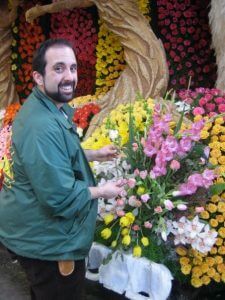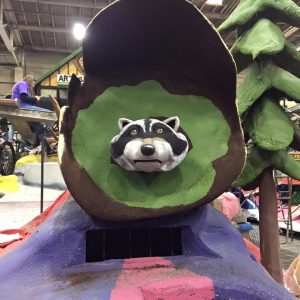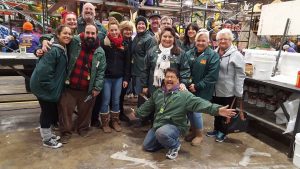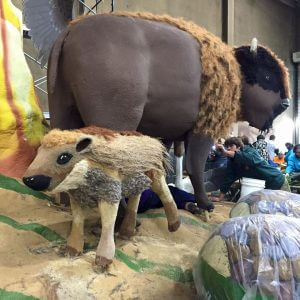If you’re like me, you couldn’t care less about watching the ball drop in Times Square tomorrow night but come from Friday morning, you’re glued to the television set for the rose parade.
Since I started writing for the floral industry close to six years ago, my fascination with this annual ritual has shifted from, “Why isn’t that pretty?” to “Aren’t my flower friends talented?!”
Knowing a few of the volunteers, both designers and flower farmers, has piqued my interest in what goes on in the days and weeks leading up to the spectacular display.
Veteran volunteer Tom Sebenius, of The Arrangement Floral Design and Gifts in New York City, has graciously taken time from his busy schedule to send me photos and share stories about working on the floats.
For those of you who don’t know Tom, he’s a Rose Parade afficionado. A Pasadena native, he attended his first parade when he was a toddler “As soon as we got home, I proceeded to pluck flowers off my mother’s camellia bushes and try to stick them to my tricycle. I then road around the neighborhood, pretending to be the winner of the Sweepstakes Trophy,” he said. “If they couldn’t have predicted my lifelong love of flowers then…well, they never would have.”
A few laters, at age 9, he started working on the floats (“they broke the rules to allow my dad to bring me along,” he said) and has done so continuously for the past 27 years. His aunt was a Rose Princess in 1953. Several family friends have served as President of the tournament. Twice he got to ride on a float. (“You have no idea how many people line the 5.5-mile route until you ride down Colorado Boulevard in its entirety,” he said.)
“It’s in my blood and I continue to be obsessed with the parade,” he said.
As a teenager, he would unpack all the flowers for the florists and separate them into buckets for them based upon the recipes provided by the Floral Director. “That’s where I learned the names of flowers and all the varieties etc.,” he said.
When he got older, Tom worked as a Crew Chief, coordinating the volunteers and overseeing the decoration of a specific float. For the past decade, he’s been on the Floral Design team, tackling the large scale floral flourishes on the floats.
This year, he’s working for the largest builder, Phoenix Decorating Company, which makes 21 of the 45 floats in the parade. Tom’s the lead florist on the West Virginia Children’s Hospital (theme: “wild and wonderful”) and Western Asset (theme: “Let your imagination run wild”).  Other volunteers include Kiwanis members, “Petal Pushers” (member of the Lutheran Laymen’s League) and a few of his students from the New York Botanical Gardens.
Other volunteers include Kiwanis members, “Petal Pushers” (member of the Lutheran Laymen’s League) and a few of his students from the New York Botanical Gardens.
Tom’s team has been working 16-hour days “and will likely work through the night on the 30th,” he said, adding that each shift typically has 300 to 500 decorators.
As far as the natural product itself, “quantifying is impossible,” he said. Seeds and dried materials are purchased in vast quantities and the flowers on one float could exceed “what the average flower shop uses in five years,” Tom said. “I once worked on one with 100,000 roses!”



